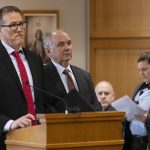Wisconsin In Bottom 20% In Per-Resident Federal Spending
But Wisconsin Policy Forum warns cuts could still be devastating.

Hundreds of protesters lined a busy intersection in La Crosse, Wis. to protest federal layoffs and funding cuts under the Trump administration on Saturday, April 5, 2025. Hope Kirwan/WPR
As sweeping federal cuts loom, a new report from the Wisconsin Policy Forum finds Wisconsin ranks near the bottom of states in terms of receiving federal payments.
Even so, researchers note federal spending reductions would have widespread effects, including for the state’s most vulnerable residents.
In federal fiscal year 2022, Wisconsin received $86.46 billion in federal payments or roughly $14,700 per person, lagging behind the national average of $16,606 per person.
“Despite this fact that most states get substantially more than we do, the federal role here is hugely important,” Stein said. “What happens with it, even in Wisconsin, is still a really big deal.”
Federal spending was about $15 billion more than what Wisconsin residents and businesses paid in federal taxes in 2022. Federal payments also exceeded combined state and local government spending of $65 billion.
Entitlement programs like Social Security and Medicare received the most in direct federal payments, amounting to $56 billion. Other payments include unemployment insurance benefits, federal grants and loans for college students, pension benefits for veterans and food benefits for the Supplemental Nutrition Assistance Program.
Medicare and Social Security programs each serve more than 1 million residents. While they’re not facing cuts, the report notes Social Security provided around $29 billion annually in payments in 2023, or an average of roughly $1,800 a month for each individual receiving benefits. Even a 1 percent change in spending could result in the loss of roughly $300 million each year.
However, Medicaid could see significant cuts or changes under a U.S. House budget proposal or the House reconciliation bill. Wisconsin received around $14 billion in federal grants paid to states, local governments and schools that support programs like Medicaid. It serves almost 1.3 million children and adults.

A 1930s-era Art Deco building is home to the state Department of Health Services in Madison, Wis. Gov. Tony Evers is calling to sell the building near the state Capitol as part of a plan that would reduce state government’s footprint in Madison by nearly 30 percent. Dori (CC BY)
Medicaid is the state’s single biggest source of federal funding
Medicaid is the state’s single biggest source of federal funding; the program budgeted to receive $7.6 billion in federal funding in the 2025 fiscal year. The state could lose tens of millions of dollars under even a small change in spending.
If the federal spending bill becomes law, Wisconsin’s Medicaid Director Bill Hanna told “Wisconsin Today” that around 63,000 childless adults are at risk of losing Medicaid coverage due to new work requirements.
“So there’s certainly the possibility that folks that should be eligible lose coverage because they can’t make it through the paperwork hurdles,” Hanna told WPR.
Republican Congressman Tom Tiffany noted almost 80 percent of voters supported work requirements for nondisabled, childless adults in a 2023 nonbinding ballot measure.
“It’s really important that we reform it, protect it and save it for those people who this program was meant for — pregnant women, the disabled, people like that,” Tiffany told WPR.
The report also notes the bill would cap the amount states can tax health care providers, which state health officials have said would cut about $740 million for Medicaid. It also doesn’t extend tax credits that ensure state residents living in poverty can get some health plans without paying a premium.
State health officials have also said Wisconsin could lose $314 million in food benefits under the “big, beautiful bill” passed by the House.
Milwaukee is likely to see bigger impacts from any Medicaid cuts as one of the poorest large cities in the nation, according to the report. Many of the city’s residents benefit from federal payments through Medicaid, as well as FoodShare and education programs. Stein said Native American reservations or rural, low-income communities with aging populations would also be affected.
As of March last year, the state had more than 18,000 federal employees, excluding military and postal workers.
Stein said cuts to federal workers are unlikely to affect the state’s overall economy, but it could make it more difficult to interact with agencies or obtain federal approvals.
The report also notes many funds and programs remain in limbo, adding Wisconsin has joined 19 lawsuits challenging federal cuts or orders.
Despite cuts, researchers note that treasury data shows federal spending has continued to rise. The federal government spent $2.4 trillion in the first four months of this year compared to $2.2 trillion during the same time last year.
New report finds Wisconsin lags behind most states in federal payments, but potential cuts still loom large was originally published by Wisconsin Public Radio.
If you think stories like this are important, become a member of Urban Milwaukee and help support real, independent journalism. Plus you get some cool added benefits.




















